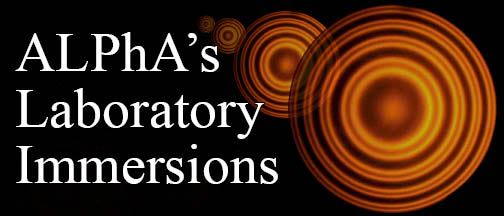- Home
- What We Do
- Laboratory Immersions
- Immersions 2019
- Imm2019HM_Quantum
Quantum Mechanics Experiments with Single Photons and Entangled Photons
Harvey Mudd College, May 29-31, 2019, two setups with space for a total of six participants
Experiments with single photons can powerfully illustrate the fundamental principles of quantum mechanics in a very simple laboratory setting. In this Immersion, participants will perform experiments on a single apparatus, illustrating two major topics: the wave/particle duality and the nature of quantum entanglement. Thirty years ago, such experiments represented a tour de force of technology and equipment; today they can be done in a few afternoons in a junior-level optics lab, thanks to current photon-counting technology and the use of nonlinear crystals to produce entangled photon pairs. Yet these experiments are still closely related to active research in quantum information and the fundamentals of quantum mechanics.
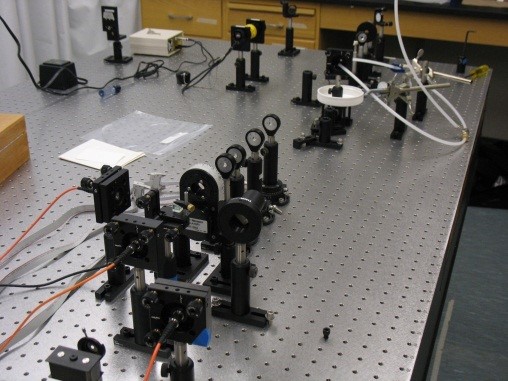
Overview of optical beam path, from pump laser at the
In this Immersion, participants will use a simple apparatus that produces near-IR photons in pairs via the process of spontaneous parametric downconversion in a nonlinear crystal, and detects them via photon-counting silicon avalanche photodiodes. The photon pairs allow for two general categories of investigation. First, we can conduct experiments on individual photons by using one member of a pair to “herald” the existence and arrival of the other member, on which the single-photon experiments are carried out. Participants will use this approach to observe the existence of single light quanta (photons), by seeing that photons incident one at a time on a beamsplitter never produce simultaneous clicks on both output ports. We will then observe that photons incident one at a time on an interferometer nevertheless exhibit interference fringes, highlighting the wave/particle duality.
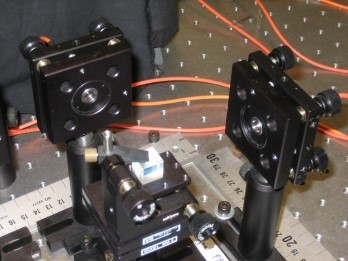 Beamsplitter and fiber couplers for existence of single photons experiment.
Beamsplitter and fiber couplers for existence of single photons experiment.
The second category of investigation makes use of the quantum-mechanical entanglement between the paired downconversion photons, most notably in their polarizations. Participants will read about and discuss Bell’s inequality, and perform a measurement of polarization correlations that clearly violates Bell’s inequality and thus rules out local hidden variable theories as an alternative to quantum mechanics.
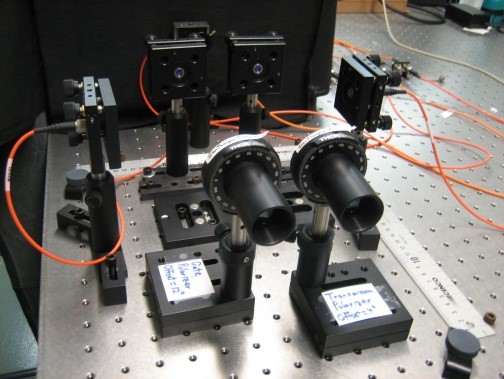 Polarizers and fiber couplers for violation of Bell's inequality
Polarizers and fiber couplers for violation of Bell's inequality
The Immersion will be three days long. The intent is to make it feasible for participants to introduce the experiments at their home campuses (total equipment cost ~ $20K to $26K, but campuses may own some components already); thus we will address alignment of the optical elements and setup and calibration of the photon-counting electronics, as well as data acquisition, analysis, and interpretation. Reading from lab manuals and selected journal articles will be assigned beforehand; participants should bring their reading, reading notes, and a lab notebook. Laser safety goggles – to be worn on their own or over prescription glasses – will be provided on site, and should be worn as directed during experimental work.
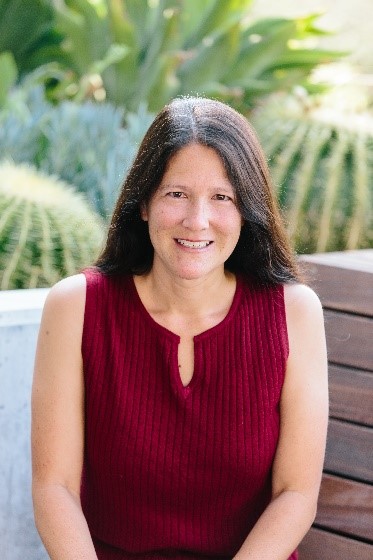 Theresa Lynn received her B.A. in physics from Harvard, and her M.S. and Ph.D. in physics from the California Institute of Technology. She was a postdoctoral scholar and staff scientist at Caltech before joining the faculty at Harvey Mudd College in 2006. Her research experience spans many areas of atomic and optical physics, including laser cooling and trapping, atom optics, cavity QED, and quantum information. Currently her research focuses on quantum communication, particularly experiments with entangled photons. Theresa has taught a wide range of courses at Harvey Mudd, including the upper-division laboratory courses in which students conduct the experiments in this immersion. She teaches a course on quantum computing and cryptography for a broad group of math and science majors and she has been involved in two major revisions of the physics department’s introductory lab curriculum.
Theresa Lynn received her B.A. in physics from Harvard, and her M.S. and Ph.D. in physics from the California Institute of Technology. She was a postdoctoral scholar and staff scientist at Caltech before joining the faculty at Harvey Mudd College in 2006. Her research experience spans many areas of atomic and optical physics, including laser cooling and trapping, atom optics, cavity QED, and quantum information. Currently her research focuses on quantum communication, particularly experiments with entangled photons. Theresa has taught a wide range of courses at Harvey Mudd, including the upper-division laboratory courses in which students conduct the experiments in this immersion. She teaches a course on quantum computing and cryptography for a broad group of math and science majors and she has been involved in two major revisions of the physics department’s introductory lab curriculum.
Theresa Lynn, Associate Professor of Physics, Department of Physics, Harvey Mudd College, 301 Platt Blvd., Claremont, CA 91711. Email Address: lynn@hmc.edu, Phone: 909-607-4493

Jason Gallicchio received his BS in electrical and computer engineering from University of Illinois, doing a thesis on far-infrared spatio-sectral interferometric imaging. He went on to get a PhD from Harvard where he worked in particle physics, first experimental and then theoretical. After a postdoc at UC Davis where he collaborated with theorists at CERN and was in the room for the Higgs announcement, he spent a year as Station Science Leader for the NSF-run South Pole Station, where he made the switch to experimental measurements of the Cosmic Microwave Background (CMB) and theoretical investigation of astronomical improvements to tests of Bell’s Inequality. Since joining the faculty of Harvey Mudd in 2016 he has published on the CMB, sub-nanosecond timing of Optical and Near-infrared Pulses from the Crab Pulsar, and an experiment in the Canary Islands with Anton Zeilinger’s group which violated Bell’s Inequality while choosing each measurement setting based on incoming light from quasars that was emitted when the universe was only a tenth as old as it is today. He has taught entanglement in his quantum mechanics class and has taught the optics lab where students perform the experiments in this Immersion.
Please note that the Jonathan F. Reichert Foundation has established a grant program to help purchase apparatus used in Laboratory Immersions. Limitations and exclusions apply, but generally speaking the foundation may support up to 40% of the cost of the required equipment.

